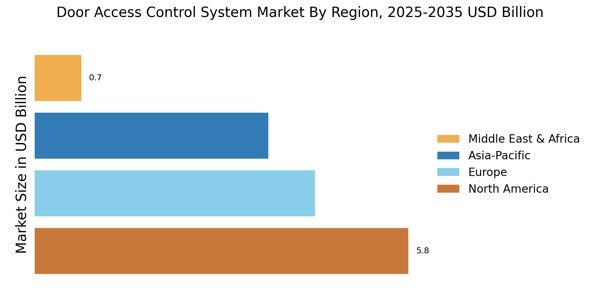Rising Security Concerns
The increasing prevalence of security threats has propelled the demand for advanced security solutions, particularly in the Door Access Control System Market. Organizations are increasingly investing in access control systems to mitigate risks associated with unauthorized access and potential breaches. According to recent data, the market is projected to grow at a compound annual growth rate of approximately 8.5% over the next five years. This growth is indicative of a broader trend where businesses prioritize security measures to protect sensitive information and assets. As security concerns escalate, the Door Access Control System Market is likely to witness heightened adoption across various sectors, including commercial, residential, and institutional environments.
Growth of Smart Buildings
The rise of smart buildings is contributing to the expansion of the Door Access Control System Market. As urbanization accelerates, there is a growing emphasis on integrating smart technologies into building infrastructure. Access control systems are becoming a critical component of smart building designs, facilitating seamless entry and enhancing overall security. The market for smart buildings is projected to reach substantial figures in the coming years, with access control systems playing a pivotal role in this transformation. This trend indicates a shift towards more automated and interconnected environments, where the Door Access Control System Market is poised to thrive as part of the broader smart technology ecosystem.
Technological Advancements
Technological innovations are significantly shaping the Door Access Control System Market. The integration of advanced technologies such as artificial intelligence, machine learning, and the Internet of Things is enhancing the functionality and efficiency of access control systems. These advancements enable real-time monitoring, automated access management, and improved user authentication processes. For instance, the incorporation of biometric recognition technologies is becoming increasingly prevalent, allowing for more secure and convenient access solutions. As these technologies continue to evolve, they are expected to drive further growth in the Door Access Control System Market, with an anticipated increase in system capabilities and user adoption.
Increased Focus on Employee Safety
The emphasis on employee safety and well-being is driving the demand for advanced access control solutions within the Door Access Control System Market. Organizations are increasingly recognizing the importance of creating secure work environments to protect their workforce. This focus on safety is leading to the adoption of access control systems that not only restrict unauthorized access but also monitor and manage employee movements within facilities. As companies prioritize employee safety, the Door Access Control System Market is likely to see a surge in demand for systems that enhance security while promoting a safe workplace culture. This trend reflects a broader societal shift towards valuing employee welfare in organizational practices.
Regulatory Compliance Requirements
Regulatory frameworks and compliance mandates are influencing the Door Access Control System Market. Organizations are required to adhere to various security standards and regulations, which necessitate the implementation of robust access control measures. Compliance with regulations such as GDPR and HIPAA is driving the demand for sophisticated access control systems that ensure data protection and privacy. As businesses strive to meet these regulatory requirements, the Door Access Control System Market is likely to experience increased investment in access control solutions. This trend underscores the importance of aligning security practices with legal obligations, thereby fostering a more secure operational environment.


















Leave a Comment